Embedded in Concrete: Reinforcing steel corrosion protection
by Katie Daniel | August 2, 2017 10:30 am
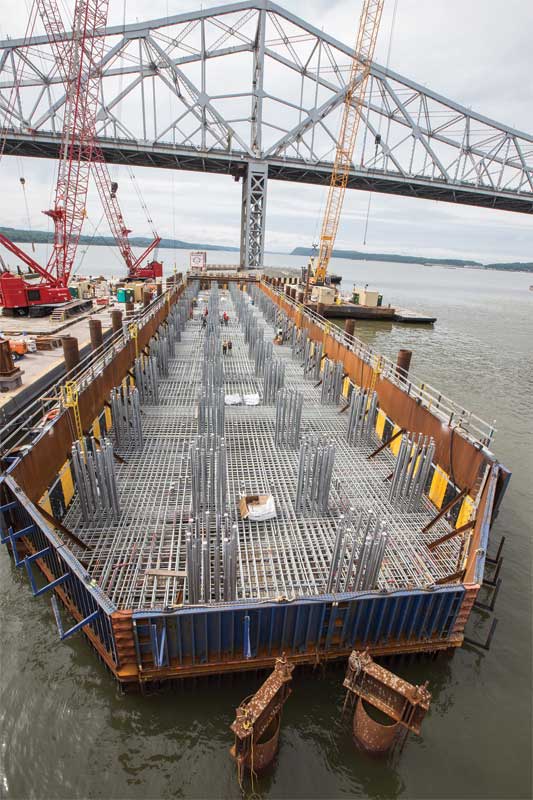 [1]
[1]by Laura Hanson
Many different types of concrete construction projects can use reinforcing steel (rebar), including architectural buildings, exposed beams and columns, bridge decks, and various transportation infrastructure projects. The steel embedded within is essential to the performance of these structures. The majority of the funding that is allocated for the more than 600,000 bridges in the United States is spent on maintenance. (This information is derived from Matt Westerfeld’s “Stainless Steel Corrosion Protection in Transportation Infrastructures Technical Paper,” published in June 2014 by a stainless steel conduit provider.) Often, this cost far outweighs the original expense of installation. Rebar corrosion protection is therefore crucial to reducing maintenance costs—but what type of rebar is best?
Concrete is a porous material, meaning water, salts, and other elements may eventually seep through it, penetrating to the steel within. It is therefore essential for weather- and water-exposed concrete to use a corrosion protection system to prolong the life of the embedded steel, ensuring integrity of the surrounding concrete. Concrete is also extremely complex, and the use of its various types has made its chemical, physical, and mechanical properties as well as its relationship to metals topics of ongoing study.
It is important to protect reinforcing steel embedded in concrete to ensure longevity and safety. Visible signs of rebar corrosion include staining, cracking, and spalling. Spalling occurs when corrosion byproducts, which are more voluminous than the metal the corrosion process consumes, accumulate within the concrete, placing increasing stress on the material. Once these stresses are greater than the tensile strength of the concrete, it will crack from within, leading to pieces of concrete separating from the structure.
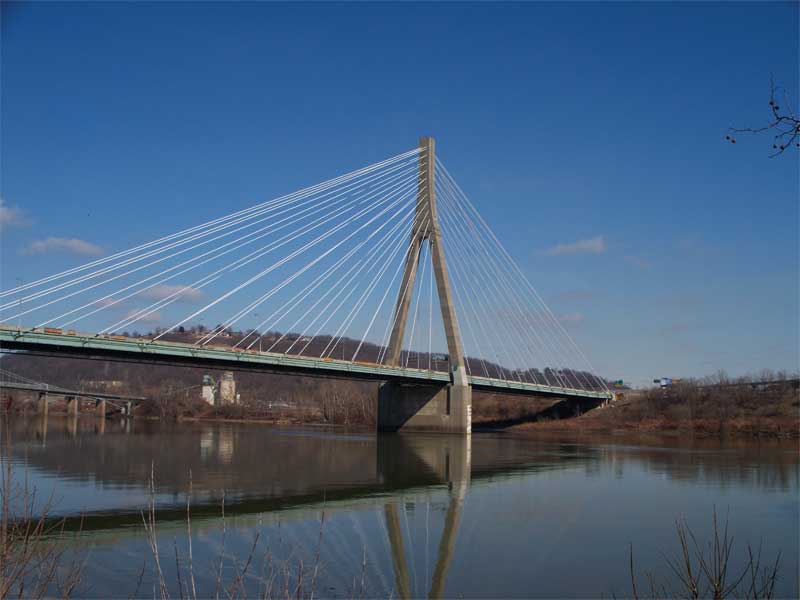 [2]
[2]Photos courtesy American Galvanizers Association
This can be dangerous for overhead structures such as overpasses, as the falling concrete imperils anything beneath or next to the structure. Under some circumstances, maintenance to repair spalling and prevent failure can be performed, but it is expensive. Galvanizing, however, protects rebar from rusting, thereby preventing the concrete from spalling. Zinc corrosion products have much less volume than black (i.e. uncoated) steel, and the corrosion products that form within the concrete migrate outward from the galvanized rebar into the concrete matrix. This prevents pressure from building up at the site of the junction between the concrete and the rebar.
Many types of reinforcing steel can be used in concrete, as can many steel corrosion protection methods. Therefore, it is important to consider the benefits of each when specifying rebar.
Types of reinforcing steel include:
- bare;
- stainless;
- martensitic microcomposite formable steel (MMFX); and
- coated.
Rebar coating types include epoxy-coated and galvanized. With such a variety of options available, choosing which type of corrosion-resistant reinforcing steel to specify can be daunting. The three most common choices are stainless, epoxy-coated, and galvanized.
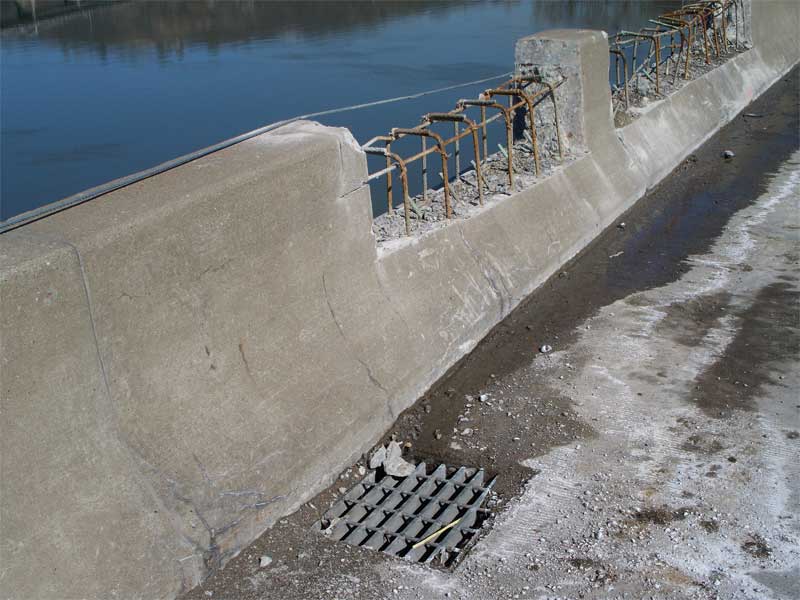 [3]
[3]Stainless steel is a newer reinforcing steel application. Therefore, there is less data available regarding its performance. So far, accelerated testing and laboratory studies indicate excellent corrosion protection and estimated long life. Epoxy-coated reinforcing steel, however, has been widely used in bridge decks and other projects since the 1970s, meaning extensive performance research is available—with varying results. Recently, epoxy-coated rebar has come under fire by many state Departments of Transportation (DOTs) for its short design life, lack of bond strength, and special handling requirements. However, its low cost can make it a solid option for less corrosive environments, where low initial cost is a major factor in early materials decisions.
Galvanized reinforcing steel has been used in concrete construction products for decades. It is hard to pinpoint the earliest use of this steel, but there are known North American projects using galvanized rebar dating back to the 1960s and 1970s. It requires no special handling, has proven to work in highly corrosive conditions, and offers a competitive initial cost and estimated long life.
| TAPPAN ZEE REPLACEMENT BRIDGE |
| Although still under construction, the New New York Bridge Project, which will replace the Tappan Zee bridge, will incorporate thousands of tons of galvanized rebar into the final design. The rebar will reinforce concrete in areas including decking, supports, and columns, and the zinc will ensure the product withstands the rigorous handling it will go through from the galvanizing tank to the pouring of the concrete. |
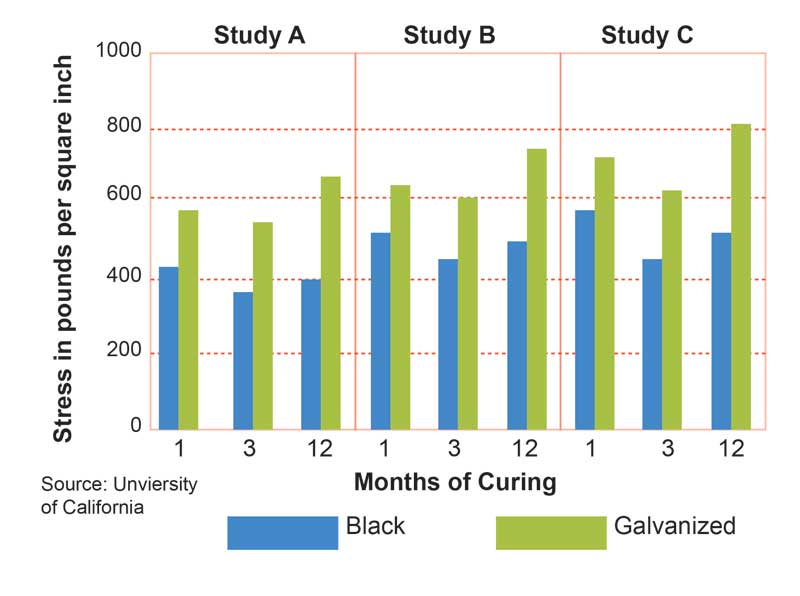 [4]
[4]A good bond between reinforcing steel and concrete is essential, as bond strength helps ensure reliable performance of the structure (Figure 1). Many factors affect the development of this bond, including environmental factors, cure time, and the chemistry of the concrete mixture. Studies of the bond strength of galvanized rebar show it offers equal or slightly better performance compared to black rebar, while epoxy-coated rebar tends to have even less bond strength than uncoated. (For more, consult S.R. Yeomans’ and D.R. Ellis’s “Further Studies of the Bond Strength and Slip Characteristics of Galvanized and Epoxy Coated Steel Reinforcement in Concrete” from the December 1992 International Lead Zinc Research Organization [ILZRO] Project Report.)
One of the biggest factors that have an influence on corrosion concrete is chloride concentration. The protective layer of zinc on galvanized reinforcing steel serves as a barrier to the many corrosive elements the rebar is exposed to when embedded in concrete. It can withstand chloride concentrations at least four to five times higher than black steel’s limit, delaying the onset of chloride corrosion. (See “Galvanized Steel Reinforcement in Concrete” by Yeomans, published by Elsevier Ltd. in 2004.) As noted, galvanized reinforcing steel corrosion byproducts tend to be less dense, and eventually migrate away from the steel and into the concrete mix. This reduces the risk of rebar failure, preventing cracking and spalling of the concrete.
Durability is important to reinforcing steel, as the bars tend to incur rough handling during installation and may be stored outside for some time before use. From installation through the use phase, galvanized rebar is abrasion-resistant and durable due to the strong metallurgical bond between the steel rebar and zinc coating, which is created during the galvanizing process. While in the galvanizing kettle, the zinc and steel react to form a series of intermetallic alloy layers, which are harder than the steel they safeguard and provide excellent abrasion resistance. This protective coating remains tightly adhered when galvanized rebar is dropped, kicked, stepped on, or rubbed against existing concrete or other rebar on the jobsite. It also withstands the effects of ultraviolet (UV) light, temperature extremes, and exposure to rain or snow, protecting the rebar both as it waits to be used and while in use.
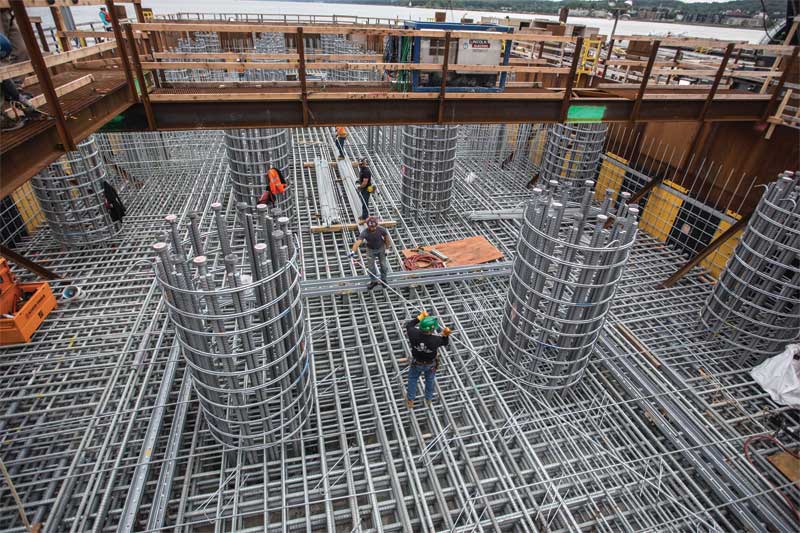 [5]
[5]Photos courtesy New York State Thruway Authority
Galvanized rebar provides a level of cathodic protection where the zinc preferentially corrodes when in contact with bare steel, making it an effective coating material for durable corrosion resistance. Stainless steel is also quite durable, but lacks the sacrificial protection of zinc. Epoxy-coated rebar must be handled very carefully during transportation and installation to avoid damaging the fragile coating.
Cost is an important factor in choosing a reinforcing steel option. Many concrete building and transportation projects are created through the use of taxpayer money, so ensuring these structures last, remaining free of maintenance and spalling, is essential. Although epoxy-coated rebar can be less expensive on an initial basis, it tends to have a shorter lifespan than other types of reinforcing steel. Stainless steel is much more expensive on an initial basis, but has an estimated lifespan of at least 75 years. Galvanized rebar shares this longevity, but is competitive with epoxy on an initial cost basis and about 25 percent the initial cost of stainless steel.
A series of standards exist to ensure reinforcing steel meets the proper procedures and industry regulations. These specifications detail requirements for finish, appearance, and adherence. ASTM A767, Standard Specification for Zinc-coated (Galvanized) Steel Bars for Concrete Reinforcement, details galvanized rebar specifications. ASTM A955, Standard Specification for Deformed and Plain Stainless-steel Bars for Concrete Reinforcement, covers stainless steel rebar. Epoxy-coated rebar must meet either ASTM A775, Standard Specification for Epoxy-coated Steel Reinforcing Bars, or ASTM A934, Standard Specification for Epoxy-coated Prefabricated Steel Reinforcing Bars. It is important to become familiar with these specifications when using reinforcing steel, as improper use may result in either a loss of adhesion and bonding or poor performance.
| VETERANS MEMORIAL BRIDGE |
| The Veterans Memorial Bridge, which spans the Ohio River to connect Weirton, West Virginia, and Steubenville, Ohio, opened on May 1, 1990. The bridge is an example of what can happen when reinforcing steel fails to withstand the environment in which it is placed. By February 2009, after less than 20 years in service, the rebar had corroded, leading to cracking and spalling of the concrete. Using rebar able to withstand the moist river environment and damaging winter road salts would have kept the concrete intact, greatly reducing the economic and time burden required to repair and replace it. |
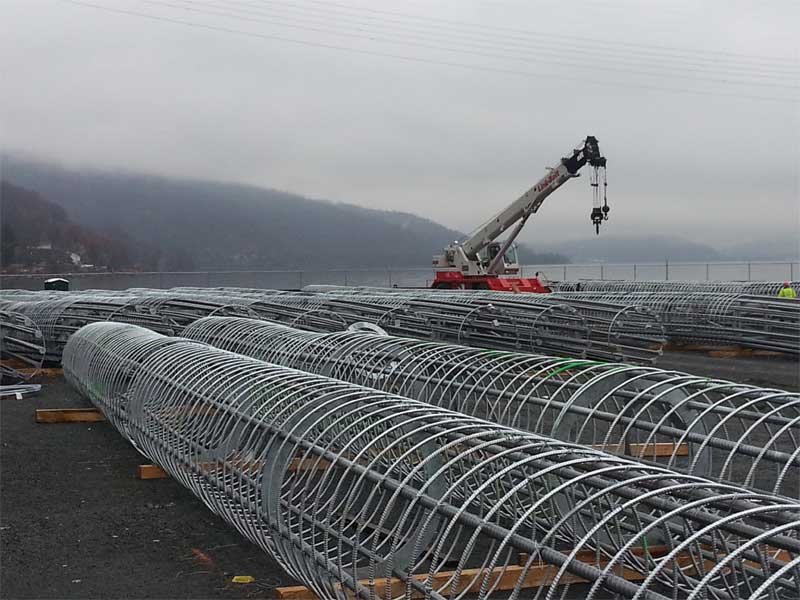 [6]
[6]Conclusion
Extensive design considerations are relevant to reinforcing steel, including bending, cutting, tying, welding, and handling. While this article does not go into detail regarding design concerns of reinforcing steel, specifiers must be aware of these considerations before making their final decisions. Durability, cost, and performance are important factors in the life of reinforcing steel, and each type of bar and coating can provide advantages in each of these areas.
Constructing projects to last 75 to 100 years saves taxpayer money while also creating a stronger infrastructure for the future. Conducting research to determine performance, application conditions, and cost, as well as communicating with those involved in the project, will ensure the correct type of reinforcing steel is chosen to provide the longest possible project lifespan, increasing safety and sustainability for the whole community.
| ATHENS BRIDGE DECK |
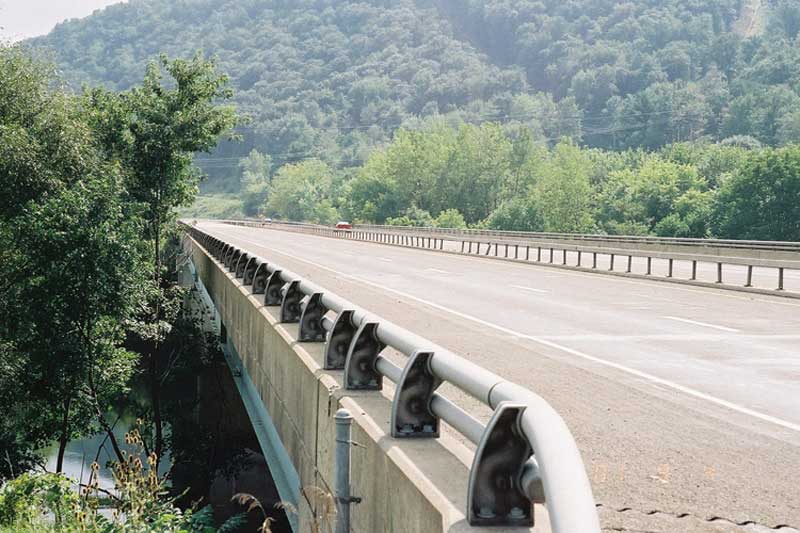 [7] [7]Photos courtesy American Galvanizers Association Built in 1973, the Athens Bridge in Pennsylvania is an 11-span, four-lane divided bridge utilizing hot-dip galvanized reinforcing bars. Its bridge deck was initially inspected eight years after installation, when concrete cores were drilled and an analysis of chloride contamination and coating thickness was conducted. The chloride levels found in the cores exhibited concentrations between 0.8 and 3.5 kg per 0.7 m3 (1.8 and 7.9 lb per 1 cy) of concrete. The high end of these concentrations was well above the threshold for active corrosion to occur on bare steel. Despite these extremely corrosive conditions, the coating thickness measurements indicated galvanized coatings approximately three times as thick as required on newly galvanized rebar according to ASTM A767, Standard Specification for Zinc-coated (Galvanized) Steel Bars for Concrete Reinforcement. The Athens Bridge was later inspected in 1991 and 2001, and the analysis generated similar results, with no sign of active corrosion found on the galvanized reinforcement. These inspections indicate the bridge will stand with at least 75 years of maintenance-free corrosion protection. |
| THE EGG |
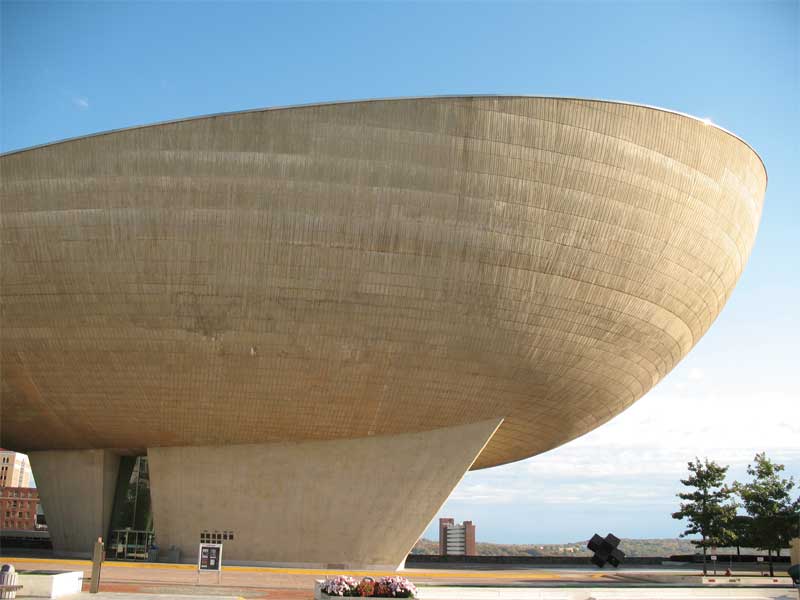 [8] [8]The Egg at the Empire Center Plaza in Albany, New York, was completed in 1978. This performing arts center was a massive undertaking of architecture, combining aesthetics and function and featuring a concrete and steel stem extending six stories into the ground. The Egg keeps its shape by wearing a girdle composed of heavily reinforced concrete beams, which use hot-dip galvanized rebar. The superior durability and corrosion protection of hot-dip galvanized steel made it the logical choice for the reinforcement of concrete in such an integral aspect of the structure’s design. The reinforced girdle helps the Egg keep its shape, and directs the weight of the structure onto the supporting pedestal and stem. Thanks to hot-dip galvanized reinforcing steel, the Egg’s extravagant design has not only wowed citizens and visitors for decades, but will remain a beautiful centerpiece of Albany for generations to come. |
Laura Hanson is the digital marketing manager for the American Galvanizers Association (AGA), where she has worked for more than six years. She leads the Rebar Focus Group for AGA members while managing all AGA digital marketing initiatives. Hanson holds degrees in design from the University of Nebraska Lincoln and in communications from the University of Denver. She can be reached via e-mail at lhanson@galvanizeit.org[9].
- [Image]: https://www.constructionspecifier.com/wp-content/uploads/2017/07/New_New_York_Bridge_01.jpg
- [Image]: https://www.constructionspecifier.com/wp-content/uploads/2017/07/Veterans_Bridge_06.jpg
- [Image]: https://www.constructionspecifier.com/wp-content/uploads/2017/07/Veterans_Bridge_09.jpg
- [Image]: https://www.constructionspecifier.com/wp-content/uploads/2017/07/Bond-Strength-Graph.jpg
- [Image]: https://www.constructionspecifier.com/wp-content/uploads/2017/07/New_New_York_Bridge_02.jpg
- [Image]: https://www.constructionspecifier.com/wp-content/uploads/2017/07/Tappen_Zee_Bridge_2014_05.jpg
- [Image]: https://www.constructionspecifier.com/wp-content/uploads/2017/07/Athens3.150.jpg
- [Image]: https://www.constructionspecifier.com/wp-content/uploads/2017/07/The-Egg022.jpg
- lhanson@galvanizeit.org: mailto:lhanson@galvanizeit.org
Source URL: https://www.constructionspecifier.com/embedded-in-concrete-reinforcing-steel-corrosion-protection/